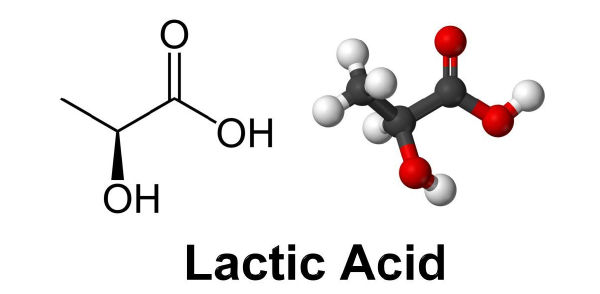We present a mathematical model for growth and control of facultative anaerobic bacterial biofilms in nutrient rich environments. The growth of the microbial population is limited by protonated lactic acids and the local pH value, which in return are altered as the microbial population changes. The process is described by a non-linear parabolic system of three coupled equations for the dependent variables biomass density, acid concentration and pH. While the equations for the dissolved substrates are semi-linear, the equation for bacterial biomass shows two non-linear diffusion effects, a power law degeneracy as the dependent variable vanishes and a singularity in the diffusion coefficient as the dependent variable approaches its a priori known threshold. The interaction of both effects describes the spatial spreading of the biofilm. The interface between regions where the solution is positive and where it vanishes is the biofilm/bulk interface. We adapt a numerical method to explicitly track this interface in x-t space, based on the weak formulation of the biofilm model in a moving frame. We present numerical simulations of the spatio-temporal biofilm model, applied to a probiotic biofilm control scenario. It is shown that in the biofilm neighbouring regions co-exist in which pathogenic bacterial biomass is produced or killed, respectively. Furthermore, it is illustrated how the augmentation of the bulk with probiotic bacteria leads to an accelerated decay of the pathogenic biofilm
By: Dr Hassan Khassehkhan

This study presents a comprehensive mathematical model to describe the growth and control of bacterial biofilms, particularly focusing on facultative anaerobic pathogens such as Listeria monocytogenes. Unlike traditional biofilm models that often focus on nutrient limitation or antibiotic disinfection, this research explores an alternative bio-control strategy: manipulating the local pH and protonated lactic acid concentrations through the introduction of probiotic bacterial species such as Lactococcus lactis.
The authors construct a nonlinear reaction-diffusion system composed of three main variables:
Biomass density (N) representing the concentration of the bacterial biofilm,
Protonated lactic acid concentration (C),
Hydrogen ion concentration (P), which determines local pH.
The core assumption of the model is that both pH and protonated acid concentrations inhibit the growth of pathogenic bacteria. As these variables increase, the local environment becomes increasingly hostile to pathogens, thereby controlling or even eradicating the biofilm.
To simulate biofilm dynamics, the authors employ a double-degenerate parabolic partial differential equation for biomass diffusion. This model includes two key nonlinear diffusion effects:
Degeneracy: As biomass density approaches zero, diffusion slows significantly, preventing unrealistic spreading into the bulk liquid.
Singularity: As biomass density nears its maximum possible value, the diffusion coefficient increases sharply, preventing densities from exceeding physical limits.
This combination ensures a realistic simulation of biofilm formation and morphology. The model also accounts for spatial heterogeneity by explicitly tracking the moving boundary between the biofilm and the surrounding fluid, a significant innovation over earlier fixed-boundary models.
To solve this complex system, the authors adapt a moving mesh finite element algorithm. This numerical technique allows the simulation to dynamically adjust the computational grid as the biofilm grows or shrinks. The growth and decay of biomass are determined by a piecewise linear function of C and P, which captures different biological phases: growth, stationary, and decay.
In the simulations, the model effectively reproduces the formation of stratified biofilms. Initially, microbial activity is highest near the biofilm-liquid interface, where nutrient and substrate access is better. Over time, as acid and proton concentrations increase due to microbial activity, these conditions extend deeper into the biofilm, leading to growth inhibition or bacterial decay.
A key application tested is a probiotic-based control strategy: introducing L. lactis into the bulk liquid, which increases acid production and lowers pH, thereby accelerating the decay of L. monocytogenes biofilms. A simple ODE system models the dynamic behavior of L. lactis in the bulk, including its own acid and proton production. The boundary conditions from this auxiliary model are then applied to the main biofilm system.
Simulation results confirm that adding probiotics significantly enhances biofilm decay. Interestingly, this control mechanism inverts the effect of antibiotics: whereas antibiotics often fail to reach bacteria in the inner biofilm layers, the pH-based control begins affecting bacteria near the substratum first, due to the accumulation of acid and low pH.
The authors conclude by highlighting the promise of this bio-control approach. They suggest that it could be further explored both experimentally and through more refined mathematical models, potentially including additional controlling factors like nutrients or oxygen. Unlike antibiotics, this method may reach and destroy bacteria deeply embedded in biofilms, suggesting a complementary or alternative treatment strategy.
 | Modeling and Simulation of a Bacterial Biofilm that is Controlled by pH and Protonated Lactic Acids |

